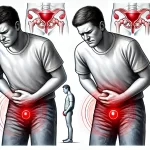First off, let’s get one thing straight (pun intended): having a curve in your penis is completely normal. Many men notice some degree of curvature when erect, and in most cases, it’s nothing to be concerned about. But if you’ve been wondering whether your curve is “too much” or if it’s causing problems, you’re not alone. Let’s talk about it with honesty and compassion.
What’s Normal?
Most penises aren’t perfectly straight. A slight curve to the left, right, up, or down is typical and doesn’t usually interfere with function. If the curve is mild and doesn’t cause pain or affect your ability to have sex, it’s likely nothing to worry about.
But if the curvature is more noticeable or is causing discomfort—physically or emotionally—it’s worth taking a closer look (and maybe having a chat with a doctor). This isn’t about being self-conscious; it’s about understanding your body and feeling confident about your health.
When is Curvature a Problem?
Here are some signs that penile curvature might need attention:
- It’s painful: Pain during erections or sex isn’t normal and can indicate something is wrong.
- It’s affecting your sex life: If the curve makes penetration difficult or uncomfortable for you or your partner, that’s a sign it might be more than a harmless bend.
- It’s getting worse: If the curve has become more pronounced over time, it could be a sign of a condition called Peyronie’s disease.
- It’s causing stress: Even if the curve doesn’t cause physical problems, it’s okay to seek help if it’s affecting your confidence or mental health.
What Causes Excessive Curvature?
Severe curvature often stems from a condition like Peyronie’s disease, where scar tissue (called plaques) forms under the skin of the penis. This can happen due to injury or, in some cases, for reasons doctors don’t fully understand. The plaques can make the penis bend, and in some cases, the condition might worsen over time.
What Can Be Done?
The good news is, you don’t have to live with discomfort or worry. Here are some potential options:
- Talk to a Specialist: A urologist can assess the degree of curvature and determine whether treatment is needed.
- Non-Surgical Treatments: In some cases, medications or injections can reduce scar tissue and improve the curve.
- Physical Therapy Devices: Devices like traction or vacuum therapy can help stretch the penis and reduce curvature over time. These devices, also called extenders, may help correcting curvature according to various studies, such as this one.
- Surgery: In severe cases where other treatments don’t work, surgery can straighten the penis and restore function.
Why This Matters
You deserve to feel comfortable and confident in your body. If you’re worried about penile curvature, you’re not being vain—it’s a valid health concern. Whether it’s causing pain, interfering with your intimacy, or just weighing on your mind, you don’t have to face it alone.
Take the First Step
If any of this resonates with you, consider reaching out to a doctor or urologist. A conversation about penile health might feel awkward at first, but professionals have heard it all before, and their goal is to help you feel better—physically and emotionally.
Remember: your health and happiness are worth it. You’re not alone, and there are solutions.
FAQ: Let’s Answer Your Questions About Penile Curvature
If you’ve got questions about penile curvature, you’re in the right place. Let’s dive into some of the most common concerns, keeping it real, straightforward, and compassionate.
1. Is penile curvature something I’m born with, or does it develop over time?
It can be either. Some men are born with a natural curve, which is usually harmless and doesn’t change much over time. This is called congenital penile curvature. Others may develop a curve later in life, often due to Peyronie’s disease, scar tissue, or an injury.
Penile curvature is relatively common among men. Mild curvature is often considered normal and doesn’t typically cause issues. However, more pronounced curvature, known as Peyronie’s disease, affects approximately 3% to 9% of men, according to Oxford Academic.
2. Can injuries during sex cause curvature?
Yes, injuries during sex or other trauma to the penis can lead to scar tissue forming, which might cause curvature. If an injury goes untreated or happens repeatedly, it could contribute to conditions like Peyronie’s disease.
3. Is it true that penile curvature can worsen with age?
For some men, yes. If the curvature is related to Peyronie’s disease, it can progress over time if left untreated. Early intervention can sometimes stop or slow the progression.
4. Can lifestyle factors make curvature worse?
While lifestyle factors like diet or exercise don’t directly cause curvature, they can play a role in your overall penile health. Smoking, for example, is linked to reduced blood flow and can make conditions like Peyronie’s harder to treat. Maintaining good circulation and general health is always a plus.
5. Are there any exercises I can do to straighten a curved penis?
Currently, there’s no proven “exercise” to fix a curved penis. However, some physical therapy devices, like traction devices, have been shown to help reduce curvature in some cases. Always consult a doctor before trying these methods.
6. Will this affect my ability to father children?
For most men, penile curvature doesn’t directly affect fertility. However, if the curve makes sex painful or difficult, it might interfere with conception. If you’re trying to start a family and curvature is an issue, a specialist can guide you on solutions.
7. Are there any warning signs I should watch out for?
Here are a few signs that warrant a closer look:
- Sudden, sharp pain during an erection.
- A noticeable lump or hard plaque under the skin of the penis.
- Curvature that appears suddenly or worsens quickly.
- Erectile dysfunction that seems related to the curvature.
8. Can penile curvature impact my mental health?
Absolutely, and you’re not alone if it has. Concerns about your body can affect your confidence, relationships, and overall mental well-being. If you’re struggling, don’t hesitate to talk to a trusted doctor—or even a counselor—about how you’re feeling.
9. Is surgery my only option if I want to fix it?
Not at all. Surgery is usually reserved for severe cases where other treatments haven’t worked. Non-invasive options like medications, injections, or traction devices are often effective, especially if addressed early.
10. How do I bring this up with my doctor?
It might feel awkward, but remember: doctors are here to help, not judge. Start by saying something like, “I’ve noticed a curve in my penis, and I’m wondering if it’s normal or if I should be concerned.” They’ll guide the conversation from there.
11. Is this something I should tell my partner about?
That’s entirely up to you, but being open with your partner can often bring relief. If the curve is affecting intimacy, sharing your concerns might help you both work through it together. Most people appreciate honesty and will want to support you.
12. How common is this?
More common than you might think! Studies suggest that mild penile curvature is present in many men, and conditions like Peyronie’s disease affect about 1 in 10 men at some point in their lives. You’re definitely not alone in this.

